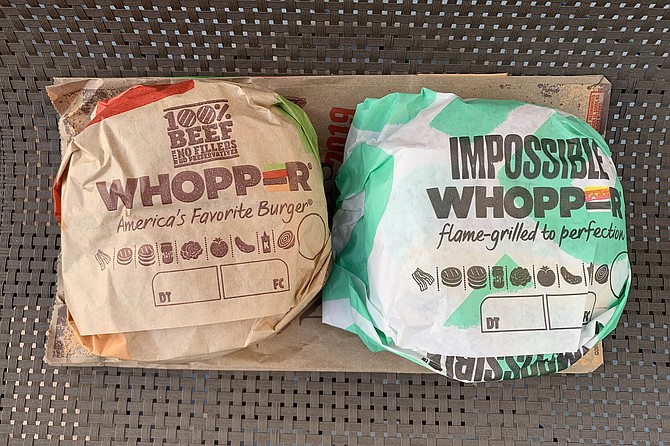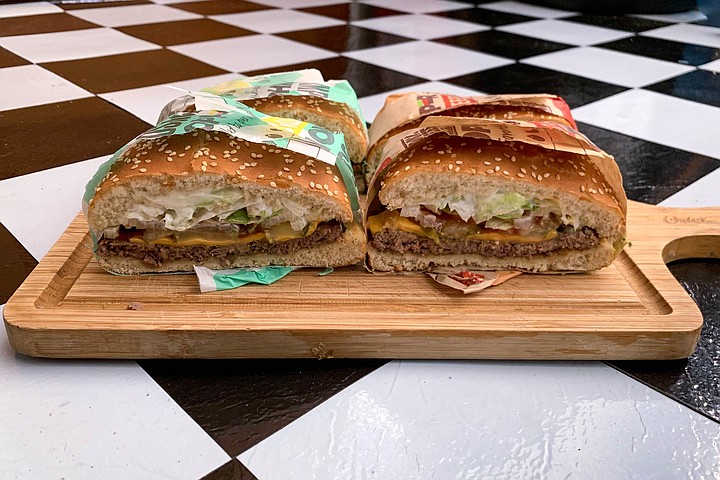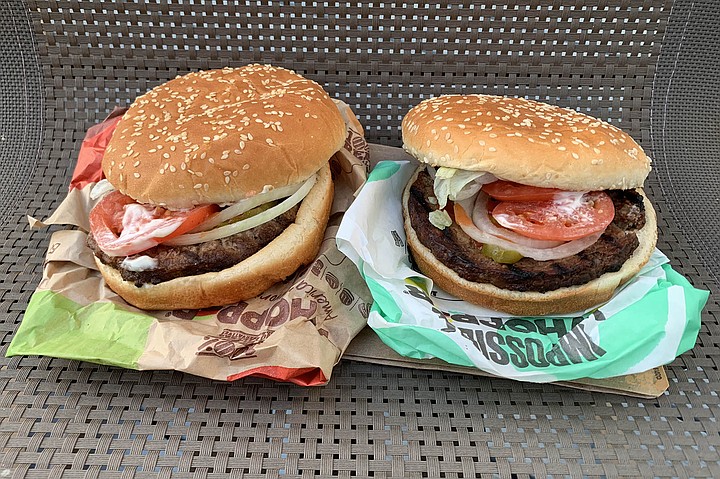 Facebook
Facebook
 X
X
 Instagram
Instagram
 TikTok
TikTok
 Youtube
Youtube

The “Where’s the beef?” commercials of the 1980s popularized the common joke that fast food restaurants skimp on beef in their burgers. Less amusing have been ongoing stories of fast food chains adding food additives and fillers to plump up their patties. And few of us can forget the shared national nightmare of eight years ago, when we learned of the existence of pink slime: beef byproduct formed into edible paste with the help of ammonia.

Fast food chains felt the heat, ditching the slime and began repeatedly hammering home the point their burgers feature only beef and nothing else. That includes Burger King’s signature Whopper, which pledges “100% beef with no fillers no preservatives," on the burger’s paper wrapper. This makes Burger King’s latest Whopper menu item almost cosmically funny: it promises zero-percent beef. Perhaps more comical: the meatless whopper costs a dollar more.

The Impossible Whopper embraces the Impossible Burger, the scientifically engineered beef substitute that debuted about two years ago, following years of high cost development in the Silicon Valley. Designed to “bleed” and sizzle on the grill, this faux beef is said to be similar enough to the real thing that vegetarian Burger King customers in Brooklyn allegedly ate all beef Whoppers, believing them to be meatless. Currently, a vegan is trying to sue the chain for grilling meatless patties on the same grill as its beef and chicken sandwiches.
Thing is, the Impossible Whopper isn’t necessarily for vegans or strict vegetarians. Other than the patty, it’s exactly the same as a regular Whopper, meaning it’s dressed with mayonnaise, and optional cheese. Its introduction seems targeted more at omnivores looking to reduce beef consumption, either due to concerns about health or environmental sustainability. People like me. So when Burger King introduced the Impossible Whopper in San Diego, along with a promotion to try both beef and non-beef whoppers side by side for $7, I gave it a shot.
Normally, a Whopper here in San Diego costs about $5, a buck more if you opt for the Impossible patty. Including cheese adds about a dollar to each. I compared versions both with and without cheese, in case that made a difference.
First came the eye test: the two burgers really are tough to tell apart by looking at them. In both cases, the Impossible burgers boasted a darker char than their all beef counterparts, while the beef patties remained just a tad thicker in the center after cooking. Flavor wise, it’s also close. Both have relatively good char flavor and plenty of savor, for a fast food burger. It’s easy to see why Burger King customers might be confused about which they’re eating. It’s tough to distinguish the differences without a direct comparison.
The cheese did help the Impossible Whopper come closer to the real thing, probably because what’s missing from the Impossible is fat content. It tastes leaner than the real beef, which has a juicier, fatty texture Impossible hasn’t managed (or perhaps wanted) to imitate. I don’t know that its reported 5-percent fewer calories makes the Impossible Whopper (630 calories) a better dietary option than the regular (660 calories), but having grown up witness to myriad fast food scandals and questionable beef industry practices, I find myself tilting towards the fake beef any occasion I don’t want to ask many questions about where the beef has been.


The “Where’s the beef?” commercials of the 1980s popularized the common joke that fast food restaurants skimp on beef in their burgers. Less amusing have been ongoing stories of fast food chains adding food additives and fillers to plump up their patties. And few of us can forget the shared national nightmare of eight years ago, when we learned of the existence of pink slime: beef byproduct formed into edible paste with the help of ammonia.

Fast food chains felt the heat, ditching the slime and began repeatedly hammering home the point their burgers feature only beef and nothing else. That includes Burger King’s signature Whopper, which pledges “100% beef with no fillers no preservatives," on the burger’s paper wrapper. This makes Burger King’s latest Whopper menu item almost cosmically funny: it promises zero-percent beef. Perhaps more comical: the meatless whopper costs a dollar more.

The Impossible Whopper embraces the Impossible Burger, the scientifically engineered beef substitute that debuted about two years ago, following years of high cost development in the Silicon Valley. Designed to “bleed” and sizzle on the grill, this faux beef is said to be similar enough to the real thing that vegetarian Burger King customers in Brooklyn allegedly ate all beef Whoppers, believing them to be meatless. Currently, a vegan is trying to sue the chain for grilling meatless patties on the same grill as its beef and chicken sandwiches.
Thing is, the Impossible Whopper isn’t necessarily for vegans or strict vegetarians. Other than the patty, it’s exactly the same as a regular Whopper, meaning it’s dressed with mayonnaise, and optional cheese. Its introduction seems targeted more at omnivores looking to reduce beef consumption, either due to concerns about health or environmental sustainability. People like me. So when Burger King introduced the Impossible Whopper in San Diego, along with a promotion to try both beef and non-beef whoppers side by side for $7, I gave it a shot.
Normally, a Whopper here in San Diego costs about $5, a buck more if you opt for the Impossible patty. Including cheese adds about a dollar to each. I compared versions both with and without cheese, in case that made a difference.
First came the eye test: the two burgers really are tough to tell apart by looking at them. In both cases, the Impossible burgers boasted a darker char than their all beef counterparts, while the beef patties remained just a tad thicker in the center after cooking. Flavor wise, it’s also close. Both have relatively good char flavor and plenty of savor, for a fast food burger. It’s easy to see why Burger King customers might be confused about which they’re eating. It’s tough to distinguish the differences without a direct comparison.
The cheese did help the Impossible Whopper come closer to the real thing, probably because what’s missing from the Impossible is fat content. It tastes leaner than the real beef, which has a juicier, fatty texture Impossible hasn’t managed (or perhaps wanted) to imitate. I don’t know that its reported 5-percent fewer calories makes the Impossible Whopper (630 calories) a better dietary option than the regular (660 calories), but having grown up witness to myriad fast food scandals and questionable beef industry practices, I find myself tilting towards the fake beef any occasion I don’t want to ask many questions about where the beef has been.
Comments